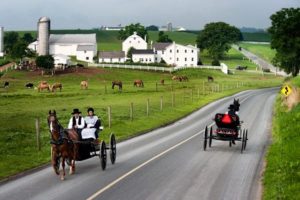The Amish and the Mennonites

Author: Robert W. Penry @ 2021
Much of the material in this article came from a variety of articles on Wikipedia and the Plain City Historical Society, with sections of my own information added. I live in an Amish Mennonite area 12 miles from Plain City, Ohio and grew up with Amish neighbors.
My 9th Great-Grandfather, Bishop Hans Herr from Switzerland, was asked by William Penn to come with his Swiss Brethern/Mennonite congregation and settle Lancaster County, Pennsylvania. Although I am not Amish or Mennonite myself, I have always been interested in this part of my ancestry.
The Amish are a group of traditionalist Christian church fellowships with Swiss Anabaptist origins. They are closely related to, but distinct from, Mennonite churches. The Amish are known for simple living and reluctance to adopt many conveniences of modern technology. The history of the Amish church began with a schism in Switzerland within a group of Swiss and Alsatian Anabaptists in 1693 led by Jakob Ammann. Those who followed Ammann became known as Amish.
In the early 18th century, many Amish and Mennonites immigrated to Pennsylvania for a variety of reasons. Today, the most traditional descendants of the Amish continue to speak Pennsylvania German, also known as “Pennsylvania Dutch”, although a dialect of Swiss German is used by Old Order Amish in the Adams County, Indiana area.
Amish church membership begins with baptism, usually between the ages of 16 and 25. It is a requirement for marriage within the Amish church. Once a person is baptized with the church, he or she may marry only within the faith. Church districts average between 20 and 40 families, and worship services are held every other Sunday in a member’s home. The district is led by a bishop and several ministers and deacons. The rules of the church, the Orfnung must be observed by every member and cover most aspects of day-to- day living, including prohibitions or limitations on the use of power—line electricity, telephones, and automobiles, as well as regulations on clothing.
Members who do not conform to these community expectations and who cannot be convinced to repent are excommunicated. In addition to excommunication, members may be shunned, a practice that limits social contacts to shame the wayward member into returning to the church.
Over the years, the Amish churches have divided many times over doctrinal disputes. The largest group, the “Old Order” Amish, a conservative faction that separated from other Amish in the 18605, are those that have most emphasized traditional practices and beliefs. The New Order Amish are a group of Amish that some scholars see best described as a subgroup of Old Order Amish, despite the name.
Two of the oldest, yet also among the smallest Ohio Amish settlements are found at Hicksville (1914) near the Indiana border, and at Plain City (18%) in Madison County. Each founded around 100 years ago, today these two settlements are barely holding on to existence, with a single church district each.
In Plain City the Beachy Amish Mennonites are formally a subgroup of Amish, but they are much less traditional. Even though they have retained the name “Amish” they are quite different from the common idea of Amish: they do not use horse and buggy for transportation, with a few exceptions they do not speak Pennsylvania German anymore, nor do they have restrictions on technology except for radio and television. In the years 1946 to 1977 a majority was transformed into an evangelical denomination by both the incorporation of revivalist Amish who had left their original churches and joined the Beachy Amish and by a growing revivalist influence.
In contrast to the Old Order Amish, the Beachy Amish Mennonites have meetinghouses, Sunday School, and a Bible School for young adults, and most also support missionary work. Excommunication is used less frequently and accompanying bans are even more rare.
Most Beachy churches today more closely resemble the Conservative Mennonites rather than the Old Order Amish. The practices and lifestyle still similar to the Old Order Amish include:
Women wear head covering
Married men have beards in most congregations
Television and radio are forbidden
Practices that distinguish the Beachy church from the Old Order Amish include:
- Filtered internet is permitted by most congregations
- Men wear ready made clothing
- Ownership of personal automobiles
For those of us that live in the area, we can tell the difference between Amish and Mennonite by appearance. The Old Order Amish wear hand-made clothing (no zippers) and the women wear long dresses of a dark material. They use horse and buggy. The men are bearded. Amish houses have neither electricity or curtains. It is impossible to tell Mennonite men and women from the rest of the population. They do not have distinctive clothing today. In past years, the Mennonite women of Plain City dressed in conservative gingham clothing and wore the kapp.
Both Amish and Mennonite women wear the head covering, a bonnet called a kapp For the old Amish, a black kapp meant the girl was single. After she married, she switched to white. The kapp was not mandatory, except for church. At home, a simple head scarf was often worn to keep the kapp clean, since it was needed for church. In recent years, at least in Plain City, many Mennonite women have stopped wearing the kapp. I taught high school in Plain City and the Amish and Mennonite girls in my classroom had a nickname for their kapps. They called them “Sin Sifters”.
The Plain City, Ohio area has two Mennonite colleges. Plain City has The Heart of Sattler College and Irwin, Ohio has the Rosedale Bible College.
The Heart of Sattler College is located at the United Bethel Mennonite Church. https://www.sattlercollege.org/events/united-bethel-men
Rosedale College is listed as an Anabaptist/Mennonite College. It is accredited and offers an associates degree in Bible Studies. It offers many courses adult education courses for general public) Home – Rosedale Bible College